Page 401 of 532
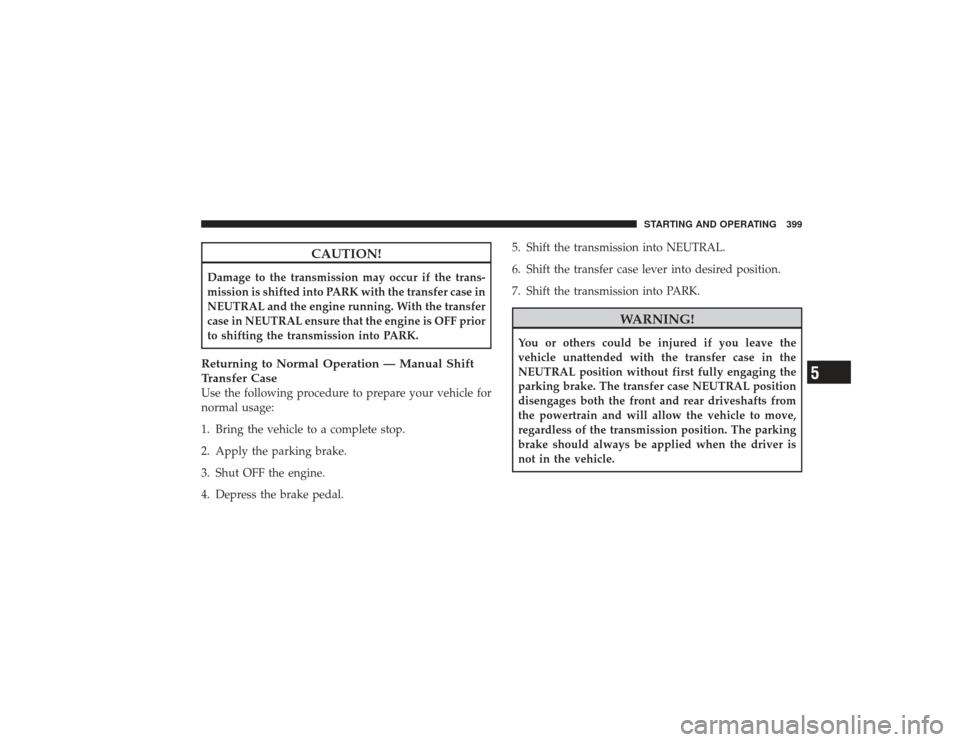
CAUTION!
Damage to the transmission may occur if the trans-
mission is shifted into PARK with the transfer case in
NEUTRAL and the engine running. With the transfer
case in NEUTRAL ensure that the engine is OFF prior
to shifting the transmission into PARK.Returning to Normal Operation — Manual Shift
Transfer CaseUse the following procedure to prepare your vehicle for
normal usage:
1. Bring the vehicle to a complete stop.
2. Apply the parking brake.
3. Shut OFF the engine.
4. Depress the brake pedal.5. Shift the transmission into NEUTRAL.
6. Shift the transfer case lever into desired position.
7. Shift the transmission into PARK.
WARNING!
You or others could be injured if you leave the
vehicle unattended with the transfer case in the
NEUTRAL position without first fully engaging the
parking brake. The transfer case NEUTRAL position
disengages both the front and rear driveshafts from
the powertrain and will allow the vehicle to move,
regardless of the transmission position. The parking
brake should always be applied when the driver is
not in the vehicle.
STARTING AND OPERATING 399
5
Page 403 of 532
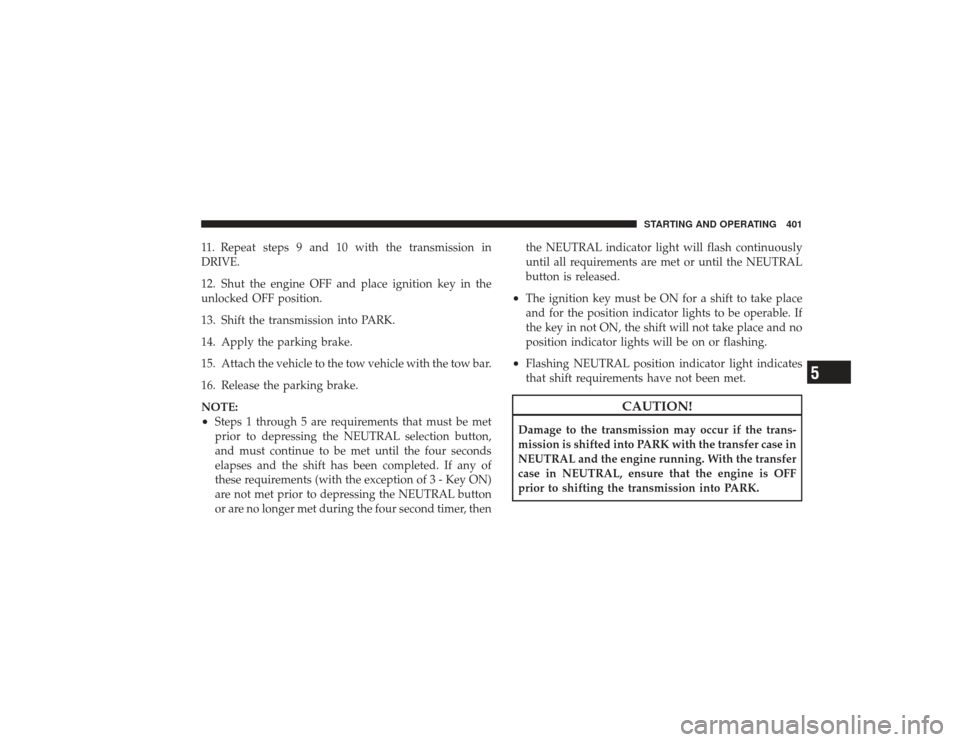
11. Repeat steps 9 and 10 with the transmission in
DRIVE.
12. Shut the engine OFF and place ignition key in the
unlocked OFF position.
13. Shift the transmission into PARK.
14. Apply the parking brake.
15. Attach the vehicle to the tow vehicle with the tow bar.
16. Release the parking brake.
NOTE:•
Steps 1 through 5 are requirements that must be met
prior to depressing the NEUTRAL selection button,
and must continue to be met until the four seconds
elapses and the shift has been completed. If any of
these requirements (with the exception of 3 - Key ON)
are not met prior to depressing the NEUTRAL button
or are no longer met during the four second timer, thenthe NEUTRAL indicator light will flash continuously
until all requirements are met or until the NEUTRAL
button is released.
•
The ignition key must be ON for a shift to take place
and for the position indicator lights to be operable. If
the key in not ON, the shift will not take place and no
position indicator lights will be on or flashing.
•
Flashing NEUTRAL position indicator light indicates
that shift requirements have not been met.
CAUTION!
Damage to the transmission may occur if the trans-
mission is shifted into PARK with the transfer case in
NEUTRAL and the engine running. With the transfer
case in NEUTRAL, ensure that the engine is OFF
prior to shifting the transmission into PARK.
STARTING AND OPERATING 401
5
Page 405 of 532
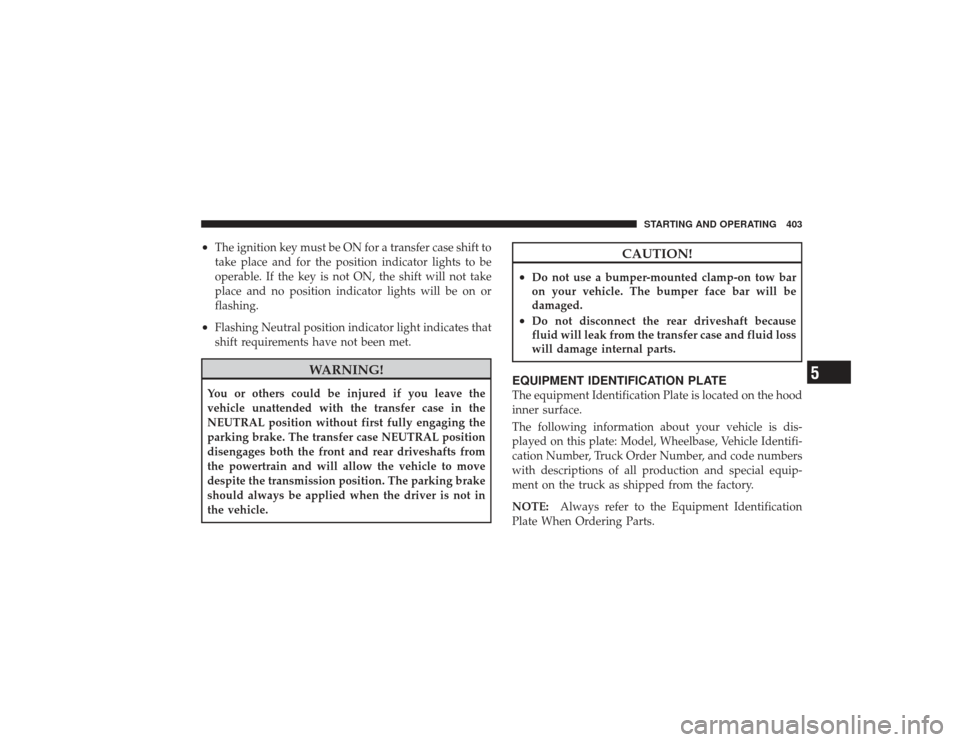
•
The ignition key must be ON for a transfer case shift to
take place and for the position indicator lights to be
operable. If the key is not ON, the shift will not take
place and no position indicator lights will be on or
flashing.
•
Flashing Neutral position indicator light indicates that
shift requirements have not been met.
WARNING!
You or others could be injured if you leave the
vehicle unattended with the transfer case in the
NEUTRAL position without first fully engaging the
parking brake. The transfer case NEUTRAL position
disengages both the front and rear driveshafts from
the powertrain and will allow the vehicle to move
despite the transmission position. The parking brake
should always be applied when the driver is not in
the vehicle.
CAUTION!
•
Do not use a bumper-mounted clamp-on tow bar
on your vehicle. The bumper face bar will be
damaged.
•
Do not disconnect the rear driveshaft because
fluid will leak from the transfer case and fluid loss
will damage internal parts.
EQUIPMENT IDENTIFICATION PLATEThe equipment Identification Plate is located on the hood
inner surface.
The following information about your vehicle is dis-
played on this plate: Model, Wheelbase, Vehicle Identifi-
cation Number, Truck Order Number, and code numbers
with descriptions of all production and special equip-
ment on the truck as shipped from the factory.
NOTE:Always refer to the Equipment Identification
Plate When Ordering Parts.
STARTING AND OPERATING 403
5
Page 411 of 532
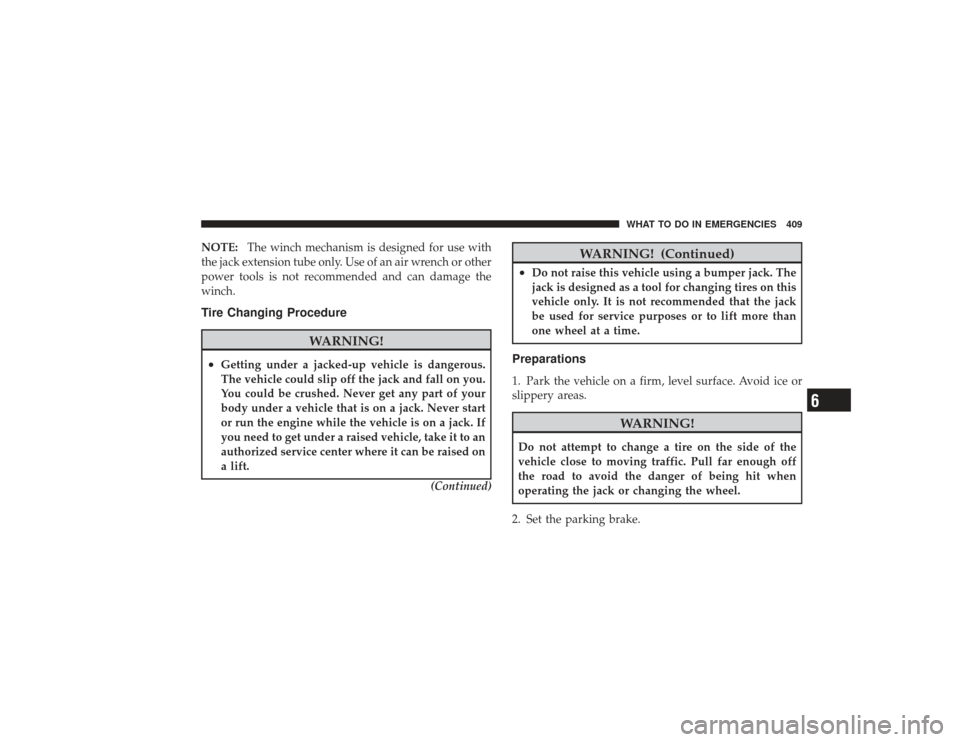
NOTE:The winch mechanism is designed for use with
the jack extension tube only. Use of an air wrench or other
power tools is not recommended and can damage the
winch.Tire Changing Procedure
WARNING!
•
Getting under a jacked-up vehicle is dangerous.
The vehicle could slip off the jack and fall on you.
You could be crushed. Never get any part of your
body under a vehicle that is on a jack. Never start
or run the engine while the vehicle is on a jack. If
you need to get under a raised vehicle, take it to an
authorized service center where it can be raised on
a lift.
(Continued)
WARNING! (Continued)
•
Do not raise this vehicle using a bumper jack. The
jack is designed as a tool for changing tires on this
vehicle only. It is not recommended that the jack
be used for service purposes or to lift more than
one wheel at a time.
Preparations1. Park the vehicle on a firm, level surface. Avoid ice or
slippery areas.
WARNING!
Do not attempt to change a tire on the side of the
vehicle close to moving traffic. Pull far enough off
the road to avoid the danger of being hit when
operating the jack or changing the wheel.
2. Set the parking brake.
WHAT TO DO IN EMERGENCIES 409
6
Page 412 of 532
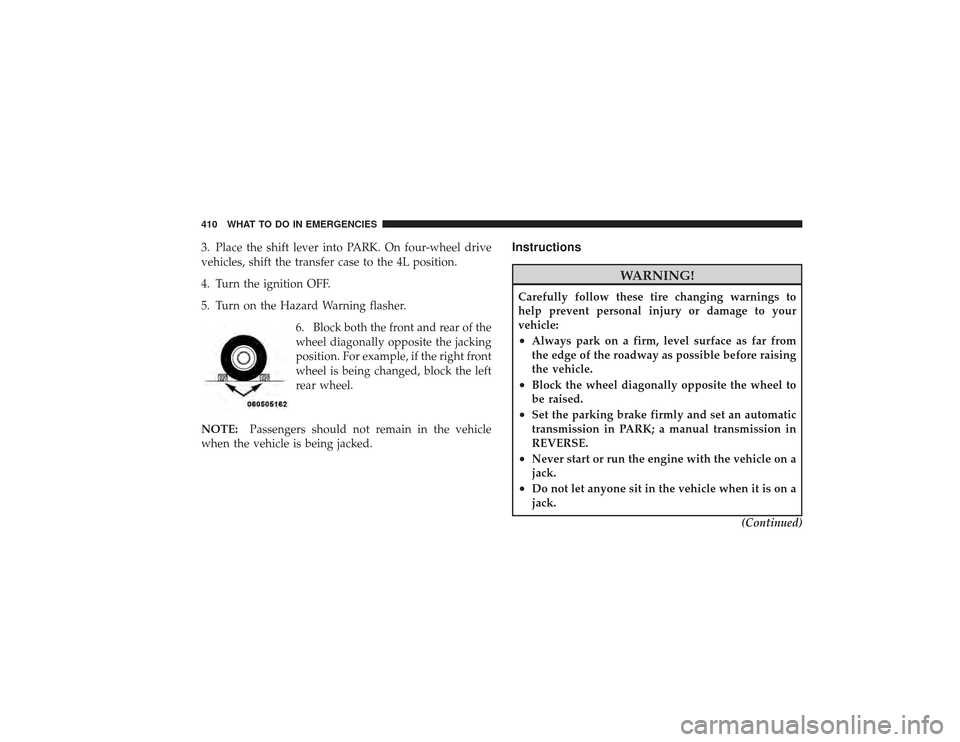
3. Place the shift lever into PARK. On four-wheel drive
vehicles, shift the transfer case to the 4L position.
4. Turn the ignition OFF.
5. Turn on the Hazard Warning flasher.6. Block both the front and rear of the
wheel diagonally opposite the jacking
position. For example, if the right front
wheel is being changed, block the left
rear wheel.
NOTE: Passengers should not remain in the vehicle
when the vehicle is being jacked.
Instructions
WARNING!
Carefully follow these tire changing warnings to
help prevent personal injury or damage to your
vehicle:•
Always park on a firm, level surface as far from
the edge of the roadway as possible before raising
the vehicle.
•
Block the wheel diagonally opposite the wheel to
be raised.
•
Set the parking brake firmly and set an automatic
transmission in PARK; a manual transmission in
REVERSE.
•
Never start or run the engine with the vehicle on a
jack.
•
Do not let anyone sit in the vehicle when it is on a
jack.
(Continued)
410 WHAT TO DO IN EMERGENCIES
Page 422 of 532

2. Park the booster vehicle within cable reach but with-
out letting the vehicles touch. Set the parking brake on
both vehicles, place the automatic transmission in PARK
and turn the ignition OFF.
3. Turn off the heater, radio, and all unnecessary electri-
cal loads.
4. Connect one end of a jumper cable to the positive
terminal of the booster battery. Connect the other end of
the same cable to the positive terminal of the discharged
battery.
WARNING!
Do not permit vehicles to touch each other as this
could establish a ground connection and personal
injury could result.5. Connect the other cable; first to the negative terminal
of the booster battery, and then to the engine of the
vehicle with the discharged battery. Make sure you have
a good contact on the engine.
WARNING!
•
You should not try to start your vehicle by pushing
or towing.
•
Do not connect the cable to the negative post of the
discharge battery. The resulting electrical spark
could cause the battery to explode.
•
During cold weather when temperatures are be-
low freezing point, electrolyte in a discharged
battery may freeze. Do not attempt jump-starting
because the battery could rupture or explode. The
battery temperature must be brought up above
freezing point before attempting jump-start.
420 WHAT TO DO IN EMERGENCIES
Page 453 of 532

3. Fully apply the parking brake and press the brake
pedal.
4. Place the shift lever momentarily into each gear posi-
tion ending with the lever in PARK.
5. Remove the dipstick, wipe it clean and reinsert it until
seated.
6. Remove the dipstick again and note the fluid level on
both sides. The fluid level should be between the “HOT”
(upper) reference holes on the dipstick at normal operat-
ing temperature. Verify that solid coating of oil is seen on
both sides of the dipstick. If the fluid is low, add as
required into the dipstick tube.Do not overfill.After
adding any quantity of oil through the oil fill tube, wait
a minimum of two minutes for the oil to fully drain into
the transmission before rechecking the fluid level.
NOTE: If it is necessary to check the transmission below
the operating temperature, the fluid level should be between the two “COLD” (lower) holes on the dipstick
with the fluid at approximately 70°F (21°C) (room tem-
perature). If the fluid level is correctly established at
room temperature, it should be between the “HOT”
(upper) reference holes when the transmission reaches
180°F (82°C). Remember it is best to check the level at the
normal operating temperature.
CAUTION!
Be aware that if the fluid temperature is below 50°F
(10°C) it may not register on the dipstick. Do not add
fluid until the temperature is elevated enough to
produce an accurate reading.
7. Check for leaks. Release parking brake.
To prevent dirt and water from entering the transmission
after checking or replenishing fluid, make certain that the
dipstick cap is properly reseated. It is normal for the
MAINTAINING YOUR VEHICLE 451
7
Page 513 of 532
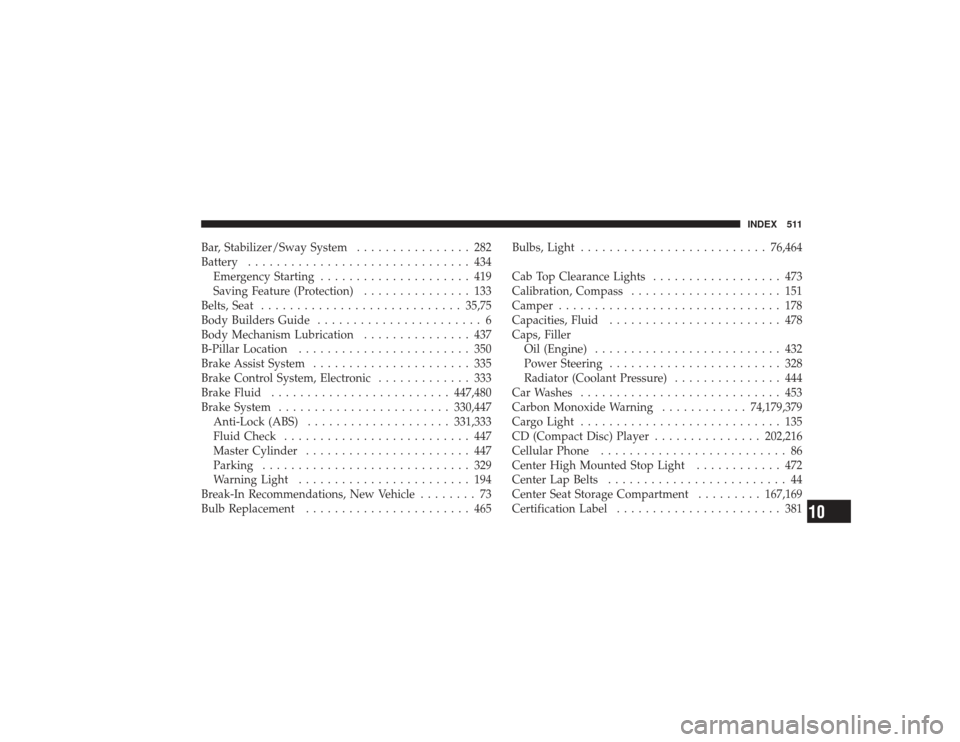
Bar, Stabilizer/Sway System................ 282
Battery ............................... 434
Emergency Starting ..................... 419
Saving Feature (Protection) ............... 133
Belts, Seat ............................ 35,75
Body Builders Guide ....................... 6
Body Mechanism Lubrication ............... 437
B-Pillar Location ........................ 350
Brake Assist System ...................... 335
Brake Control System, Electronic ............. 333
Brake Fluid ......................... 447,480
Brake System ........................ 330,447
Anti-Lock (ABS) .................... 331,333
Fluid Check .......................... 447
Master Cylinder ....................... 447
Parking ............................. 329
Warning Light ........................ 194
Break-In Recommendations, New Vehicle ........ 73
Bulb Replacement ....................... 465 Bulbs, Light
.......................... 76,464
Cab Top Clearance Lights .................. 473
Calibration, Compass ..................... 151
Camper ............................... 178
Capacities, Fluid ........................ 478
Caps, Filler Oil (Engine) .......................... 432
Power Steering ........................ 328
Radiator (Coolant Pressure) ............... 444
Car Washes ............................ 453
Carbon Monoxide Warning ............74,179,379
Cargo Light ............................ 135
CD (Compact Disc) Player ...............202,216
Cellular Phone .......................... 86
Center High Mounted Stop Light ............ 472
Center Lap Belts ......................... 44
Center Seat Storage Compartment .........167,169
Certification Label ....................... 381
INDEX 511
10